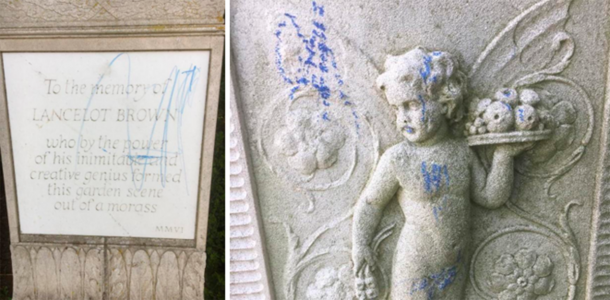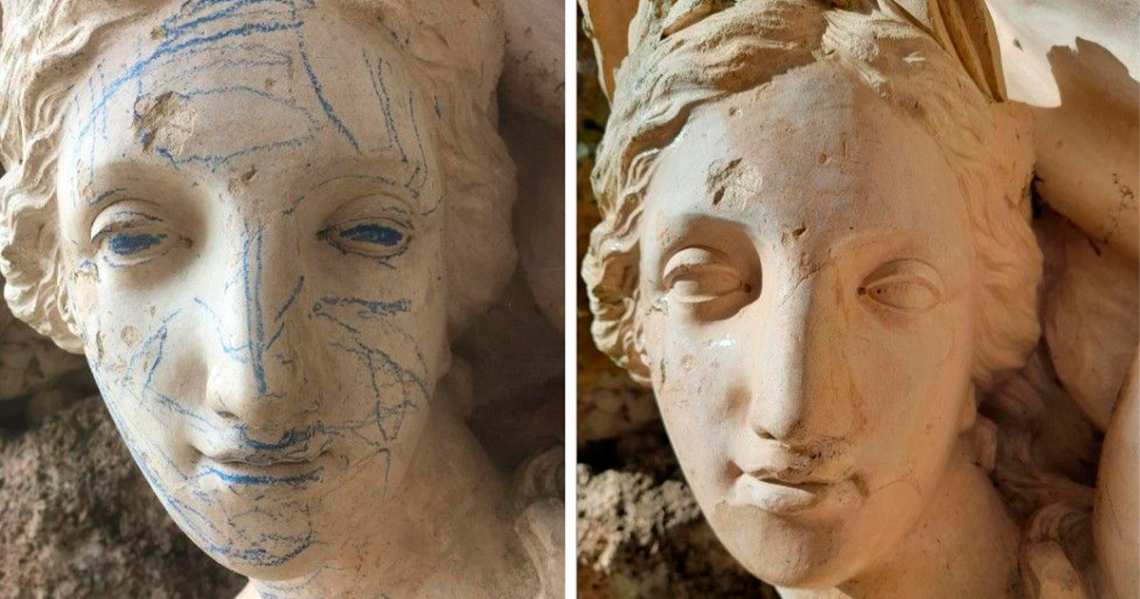On Saturday, April 8, tour guides at the historic Croome Court estate in Worcestershire were stunned to find crayon markings all over a statue and memorial plaque located on the court’s sprawling landscape grounds. At some point during the day, it seems that vandals taking a walking tour of the mansion’s peaceful and beautiful gardens had decided to mark up the 200-year-old sculptures with a bright blue crayon. The markings appear to have been made at random, suggesting the graffiti was added quickly and without any forward planning.
The desecrated objects included a statue of a Roman water nymph known as Sabrina, which was created by renowned sculptor John Bacon in the early 19th century. The statue has long been one of the feature attractions at Croome Court, where it was installed in an elaborate, decorated grotto complete with a running fountain (which no longer functions).
The second defaced object was a memorial plaque featuring a small angelic or cherubic figure, which was made in 1783 in acknowledgement of 18th century landscape architect Lancelot ‘Capability’ Brown, who was commissioned by the Sixth Earl of Coventry in 1751 to redesign the house and parkland at Croome Court . Brown’s responsibility was to convert a crumbling, preexisting structure surrounded by an underdeveloped landscape into a grand estate fit for aristocratic occupation, and the result was the huge Neo-Palladian mansion and marvelously landscape gardens that have been carefully preserved at the site to this day.
The National Trust , which manages the popular tourist attraction, declared itself “dismayed” at the thoughtless desecration of the two works of art, and at the breach of trust this action displayed.
“The overwhelming majority of visitors to Croome at the weekend were respectful to the place and to each other, enabling everyone to enjoy themselves and create wonderful memories with family and friends,” a National Trust spokesperson said in a statement to United Kingdom media sources :
“It is upsetting that the actions of a few mean that a beautiful historical statue and memorial cannot currently be enjoyed fully by visitors.”
Kids Will Be Kids
So, who exactly were the nefarious vandals who disgraced the nation by scrawling childish marks across the much-admired statue of Sabrina and on the lovely memorial dedicated to landscape artist Capability Brown?
After some brief amateur detective work, officials from the National Trust have concluded that these miscreants were in fact not thugs or delinquents, but actual children, doing what children will do when given crayons and told to have some fun.
It seems that activity packages that included the crayons were distributed to visiting families over the Easter weekend. At Croome Court all visitors are encouraged to explore landscape grounds, and during their trip round the estate it appears that kids from at least one family decided to use the white facades of the Sabrina statue and the Capability Brown memorial as coloring boards (presumably while their parents were distracted and looking the other way).
The statue of Sabrina, designed by the 18th-century sculptor John Bacon covered with blue crayon after the Easter weekend. ( National Trust )
“Disappointing as they are, incidents like this are very rare considering the millions of visitors who enjoy and respect the places in our care,” the National Trust spokesperson said.
But kids will be kids, and when those kids have crayons, they will eventually have to color something, with or without permission from their parents or other adults.
Thankfully, crayon markings can be washed off stone statues without too much difficulty, so no permanent damage has been done as a result of this incident.
“We are pleased to report we have been able to remove the crayon from the Sabrina statue this morning, so it can once again be fully enjoyed by visitors,” the spokesperson said. “We are still in the process of cleaning the Lancelot ‘Capability’ Brown memorial.”

Memorial plaque to Lancelot ‘Capability’ Brown was vandalized as well. ( National Trust )
The Croome Court Sculptures Must Be Protected!
The nymph known as Sabrina was a naiade, which is a type of water spirit associated with the mythological traditions of ancient Rome. This particular nymph was said to have lived in the Severn River , which passes right by the Croome Court estate. Her statue was carved from Coada stone, which is a variety of ceramic made from a mixture of clay, terracotta, silicates and glass. It was created by sculptor John Bacon in either the 1780s or in 1802, depending on which source someone chooses to believe.
The Sabrina statue was placed in a grotto or artificial cave, which was once decorated with exotic shells, coral and gems and supplied with water from a drainage system. The water was piped in and flowed from an urn that Sabrina held in her right hand, running down a hill and into the Severn on the estate’s western boundary.
Before being hired to redesign the house and grounds at Croome Court, Lancelot ‘Capability’ Brown was known exclusively for his work on landscapes. This was the largest project he ever took on, and his success at Croome Court helped cement his reputation as one of England’s most esteemed full-service architectural designers.
When he passed away in 1783 the memorial in his honor was erected almost immediately.
“In memory of Lancelot Brown, who by the power of his inimitable and creative genius formed this garden scene out of a morass,” its inscription reads.
Croome Court and its gardens are currently managed as a tourist attraction by the National Trust, on behalf of the Croome Heritage Trust. While the organization was flustered and a little embarrassed by this incident (how did the kids manage to pull off this stunt right under the noses of estate tour guides?), they are pleased that no real damage was done. They have undoubtedly learned their lesson from this traumatizing experience, and from now on will likely confiscate crayons from any children who arrive to tour landscape grounds.
Top image: 200-year-old sculptures marked with blue crayon at Croome Court. Source: National Trust
By Nathan Falde
